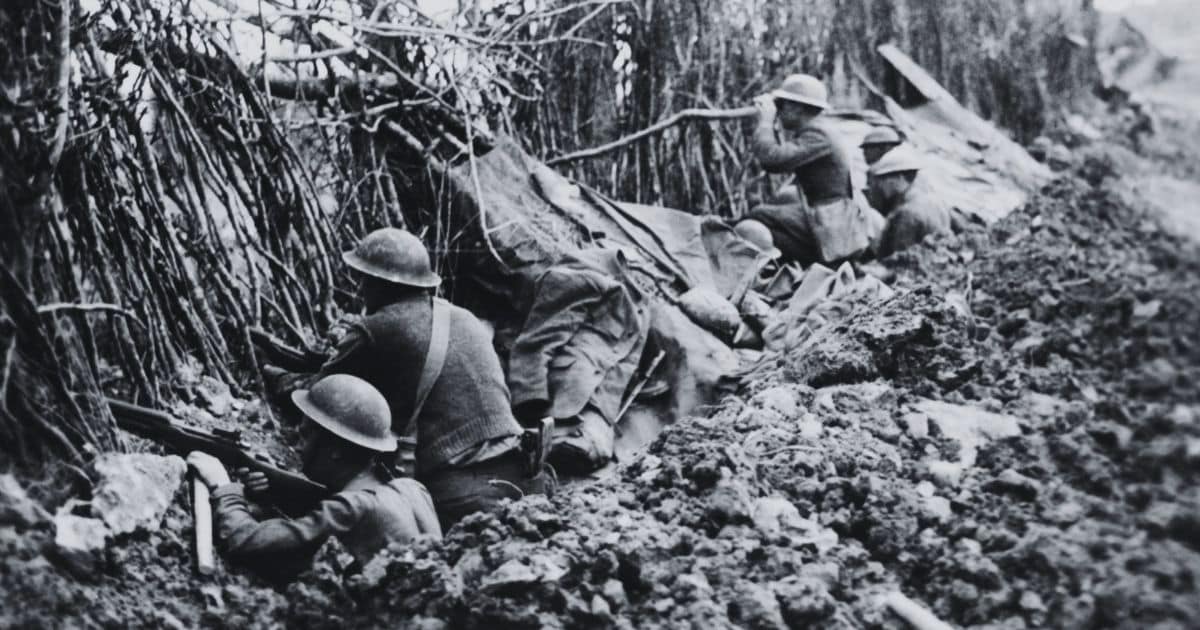World War I was an extremely bloody war that engulfed Europe from 1914 to 1918, with huge losses of life and little ground lost or won. Fought mostly by soldiers in trenches, World War I saw an estimated 10 million military deaths and another 20 million wounded.
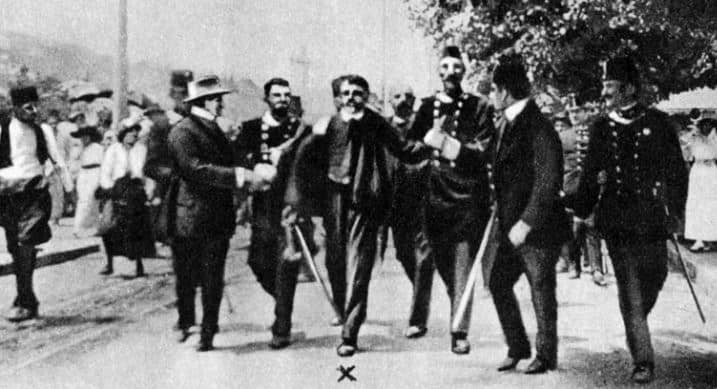
The arrest of Gavrilo Princip, the assassin of Franz Ferdinand
The so-called “war to end all wars” began after the heir to the Austrian throne, Archduke Franz Ferdinand, was gunned down by a young Serbian terrorist on June 28, 1914.
Events quickly escalated as Kaiser Wilhelm of Germany urged Austria to declare war on Serbia. Czar Nicolas of Russia then mobilized against Austria. (Believe it or not, Kaiser Wilhelm and Czar Nicolas were both grandsons of Queen Victoria of Britain, and were not fond of each other). Germany mobilized against Russia. France and Britain then mobilized against Germany. Such was the situation in July 1914 at the beginning of WWI.
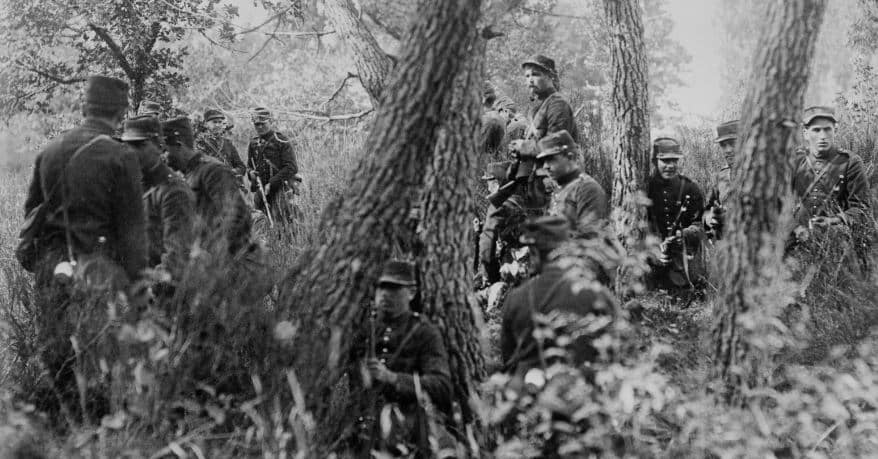
French soldiers in woods, during the first months of the war. Possibly during the Battle of the Marne. Ca. September 6-12, 1914.
In the late summer of 1914, German and French commanders both anticipated a strategy that would involve large troop movements, as each side sought to gain or defend territory. While the Germans initially swept through parts of Belgium and northeastern France, Allied forces pushed them back in the First Battle of the Marne (September 1914). At this point, the Germans dug in to avoid losing any more ground. German commander General Erich von Falkenhayn ordered the construction of defensive trenches so the Allied forces couldn’t overrun his men.
The Allies (France and Britain, at this point in the war) responded in kind and two long trenches were dug from the coast of France to Switzerland, which came to be known as the Western Front.
The trenches mostly ran alongside each other, separated by as much as one kilometer to as little as 15 meters apart. By October 1914, neither army could advance its position, mainly because this conflict was being waged very differently from how wars had been fought in the 19th century. Forward-moving strategies such as head-on infantry attacks were no longer effective or feasible against modern weaponry like machine guns and heavy artillery; this inability to move forward created the stalemate.
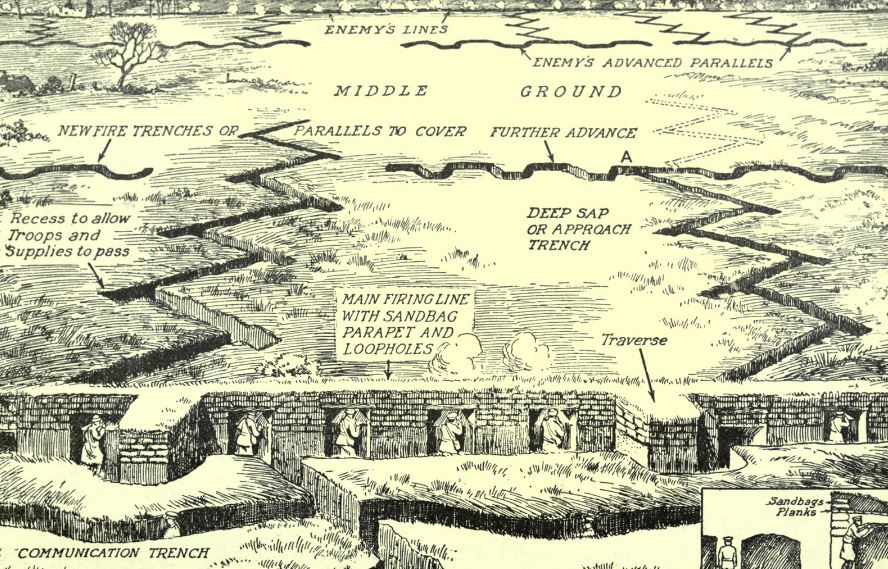
Diagram of a typical trench complex on the Western front. Ca. 1915-18.
What began as a temporary strategy by the high command evolved into one of the main features of the war at the Western Front for the next four years. In these trenches, soldiers on both sides of the conflict were exposed to disease, poison gas, and …..substantial noise exposure.
WW1: The Trenches
During trench warfare, opposing armies conducted battle at close range from a series of ditches dug into the ground. This occurred when two armies faced a stalemate, with neither side able to advance and overtake the other. Although trench warfare has been employed since ancient times, it was used on an unprecedented scale on the Western Front during World War I.
First-hand accounts illustrate the horrors of life in the trenches. One soldier wrote:
“A good standing trench was about six foot deep, so that a man could walk upright during the day in safety from rifle-fire. In each bay of the trench we constructed fire-steps about two feet higher than the bottom of the trench, which enabled us to stand head and shoulders above the parapet. During the day we were working in reliefs, and we would snatch an hour’s sleep, when we could, on a wet and muddy fire-step, wet through to the skin ourselves. “
To set up a good trench, another said, “Select a flat 10-acre plowed field, so sited that all the surface water of the surrounding country drains into it. Now cut a zig-zag slot about four feet deep and three feet wide diagonally across, dam off as much water as you can so as to leave about 100 yards of squelchy mud; delve out a hole at one side of the slot, then endeavor to live there for a month on bully beef and damp biscuits, whilst a friend has instructions to fire at you with his Winchester every time you put your head above the surface.”

The intensity of World War I trench warfare was such that about 10% of the fighting soldiers were killed. Medical services were primitive and antibiotics had not yet been discovered. Relatively minor injuries could prove fatal because of the onset of infection and gangrene. The Germans recorded that 15% of leg wounds and 25% of arm wounds resulted in death, mainly through infection.
The Americans (who did not enter the war until 1917) recorded 44% of casualties who developed gangrene died. Half of those wounded in the head died and 99% of those wounded in the abdomen died. Seventy-five percent of wounds came from shell fire. A wound resulting from a shell fragment was usually more traumatic than a gunshot wound. Not to mention the rats in these trenches and the diseases that they produced. On ‘life’ in the trenches.……. “It will be clear from all this that life in and around the trenches was filthy, foul, sickening, deafening, dispiriting and extremely unhealthy. It was safer than in no man’s land, but that was about all.”
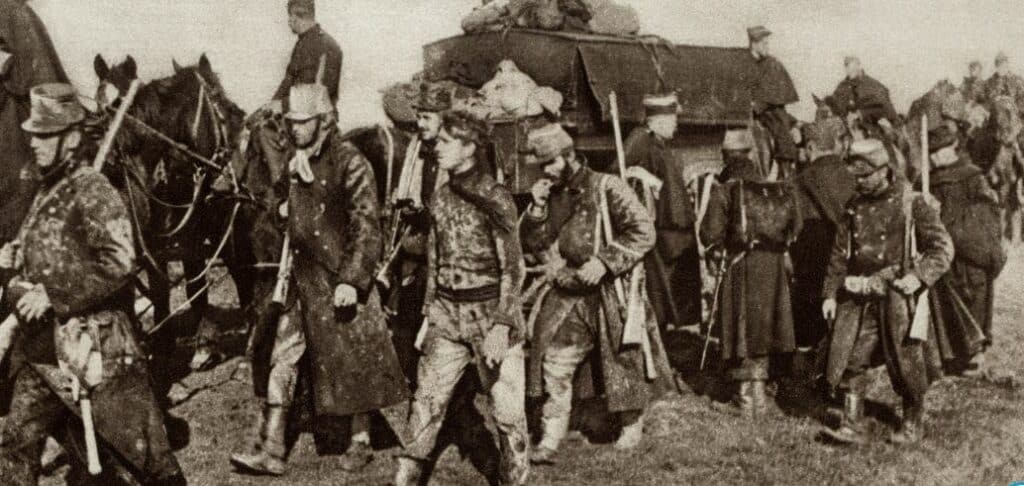
Belgian troops, weary and mud-covered from fighting in the trenches moving forward to take up a new position near Veurne. 1914.
The Noise of the Trenches
On any day it was noisy in the trenches, but on a heavy combat day it, the noise was deafening. The constant firing and banging of the artillery shells was enough to drive anybody mad, which indeed it did, often causing what was called “shell shock” and is now recognized as post-traumatic stress disorder.
Artillery rounds created noise levels of 140 dB or more, which were often heard in London some 200 miles from the front. The scream and explosion of the shells as they landed, the gunfire, grenades, and other high-intensity noises were, of course, far from the greatest of soldiers’ worries during their time in the trenches. There were also the flies, moaning of the wounded, and the stomach-turning stench of gas and decaying corpses. However, the din of war added to the horror.
During a bombardment the noise was loud enough to split the eardrums and it quite commonly caused permanent hearing loss, especially among gunners. The sound of one shell bursting nearby is deafening, let alone thousands. Many men said they did not so much hear the noise as feel it. A Canadian soldier even wrote that it had assumed a tangible form; for him the barrage had become a “solid, immovable ceiling of sound.”
In combat, the rule is, of course, to stay alive and inflict as much harm as possible on the enemy, and so the loss of hearing becomes secondary.
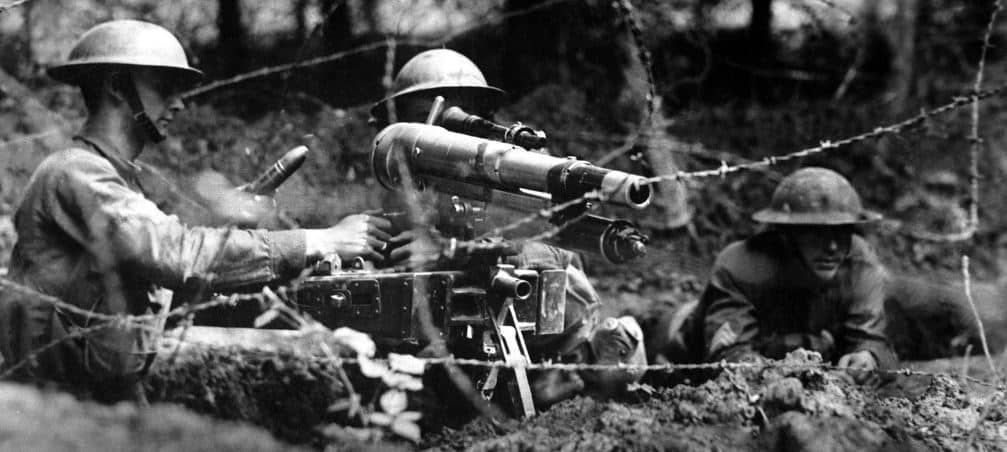
Exploding grenades present an impulse of 164 dB, mortars that began combat duty during WWI were exceedingly noisy impulses at about 185 dB, automatic fire from Chauchat and Maschinengewehr 08 as well as the almost constant gunfire from small arms. Noise was everywhere….
Noise, Hearing Loss and Ear-related Disabilities
It is now well known that noise is a health hazard. WWI saw the first use of magazine and belt-fed weapons using metal cartridges filled with smokeless-powder, which greatly increased the energy and noise of the gases exiting the muzzle.
High explosive replaced black-powder and there was a dramatic increase in the numbers with hearing damage. In the French Army the wartime prevalence of pensionable ear disabilities was 10%-20%, almost all due to NIHL. However, in England, the Oxford War Primers dismissed soldiers who reported hearing loss as malingerers who were exaggerating. After the war Major T Jefferson Faulder RAMC reported hearing deficit from gunfire to be temporary.
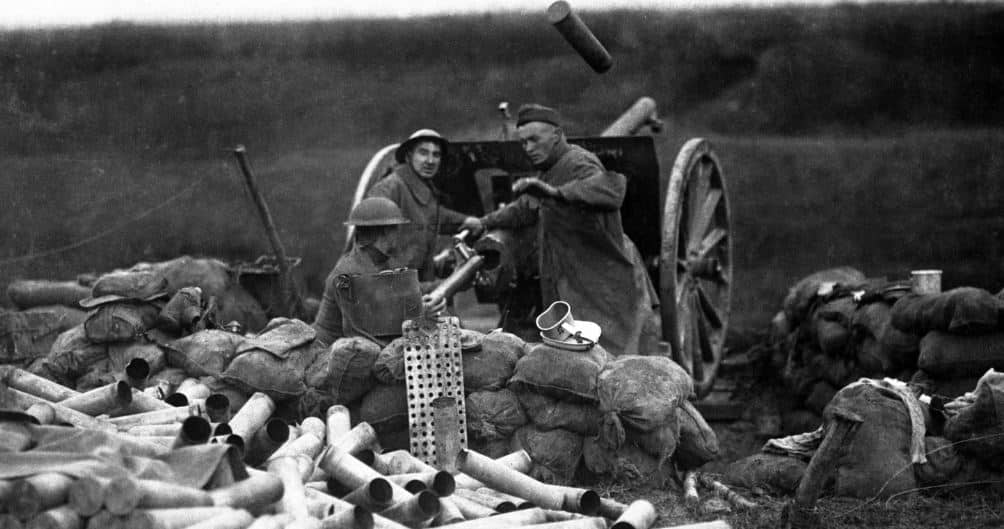
American Field Artillery on the Lorraine front in Beaumont, France. An ejected shell case flies through the air as a new shell is put into the breech in the same a second. World War I. Sept. 12, 1918.
It is easy looking back to criticize the WWI commanders for not emphasizing the use of hearing protection devices. However, back then noise was not widely known to be a health hazard and thus, earplugs were not considered except in the noisiest areas. Indeed, in the U.S. earplugs were not recommended for Army personnel until 1941 .
The focus during WWI was on surviving to go home and, at times, using hearing protection could be quite dangerous if soldiers wearing earplugs could not hear orders, warnings, or direction of fire, etc. through them. There is no research to determine the actual degree, type, and configuration of hearing impairment suffered by WWI trench soldiers. But based on their exposure to deafening conditions one can reasonably estimate that not only would significant hearing loss be common among soldiers on both sides, and also that, given what is currently known about noise-induced hearing impairment, that those exposed to this much noise over a significant period of time in the trenches of the Western Front probably ended up with at least a slight/mild to severe high-frequency, sensorineural hearing impairment, similar to that shown in the audiogram above or worse, depending upon the proximity to the exposure.
About the author

Robert M. Traynor, Ed.D., is a hearing industry consultant, trainer, professor, conference speaker, practice manager and author. He has decades of experience teaching courses and training clinicians within the field of audiology with specific emphasis in hearing and tinnitus rehabilitation. He serves as Adjunct Faculty in Audiology at the University of Florida, University of Northern Colorado, University of Colorado and The University of Arkansas for Medical Sciences.
**this piece has been updated for clarity. It originally published on April 1, 2014



